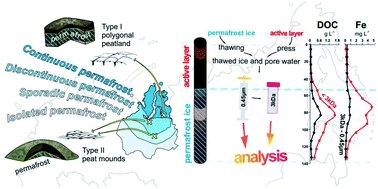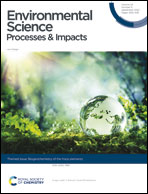Organic carbon, and major and trace elements reside in labile low-molecular form in the ground ice of permafrost peatlands: a case study of colloids in peat ice of Western Siberia†
Abstract
The fate of organic carbon (OC), nutrients and metals accumulated in thawing permafrost ice is at the forefront of environmental studies in the Arctic. In contrast to a fairly good understanding of the chemical nature of dissolved OC (DOC) and metals in surface Arctic waters, the speciation and colloidal status of solutes accommodated in the dispersed ground ice remain virtually unknown. Here we used a size fractionation procedure (centrifugal ultrafiltration) to quantify the proportion of colloidal (3 kDa to 0.45 μm) and conventionally dissolved low molecular weight (LMW<3 kDa) fractions of DOC, and major and trace elements in the porewater and ice of 5 peat cores sampled along a 400 km permafrost and climate gradient in the largest peatland in the world, the Western Siberian Lowland (WSL). We discovered that the strong (a factor of 2 to 10) increase in the total dissolved (<0.45 μm) concentration of DOC and most major and trace elements in the peat ice relative to the peat porewater from the thawed layer was essentially linked to an increase in the LMW<3 kDa fraction. This increase in the potentially bioavailable fraction in the peat ice relative to the porewater was especially pronounced for DOC, P and many trace elements including metal micronutrients, and was observed throughout all permafrost zones. This contrasted with element distribution in the upper (thaw) layer, where the majority of these elements were present in the colloidal pool. Following previous experiments on permafrost peatland surface waters, we hypothesized that the freeze–thaw cycles of peat porewater were responsible for generation of the LMW fraction in the bottom part of the peat core. Results of this study demonstrate that carbon, and macro- and micro-nutrients as well as trace metals in ground ice of permafrost peatlands are essentially present in a low molecular weight (<3 kDa) and potentially bioavailable form that can strongly impact the riverine export fluxes of solutes during permafrost thaw.

- This article is part of the themed collections: Geochemistry, Best Papers 2022 – Environmental Science: Processes & Impacts and Biogeochemistry of the Trace Elements


 Please wait while we load your content...
Please wait while we load your content...